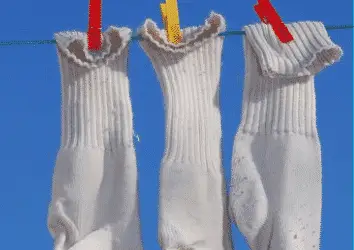At the end of a long hike my socks are usually soaked in sweat (it gets nasty). For years I suffered, having to wake up and put back on socks that only partially dried. Throughout the years I’ve developed a system that guarantees dry socks regardless of the weather.
How to Dry Wet Socks When Camping and Backpacking
So how do you dry wet socks when camping and backpacking? It’s all about finding the right socks, airing them out to dry, and using either your body heat or an external heat source to dry them overnight.
- Choose the Right Socks: Start off by bringing a couple of pairs of either moisture-wicking synthetic socks or merino wool(my favorite wool socks). I’m not talking about the scratchy wool socks your grandfather probably wore. Modern merino wool socks are actually extremely comfortable with natural moisture-wicking properties making them warm in the winter and cool in the summer.
- Air Them Out: At the end of your hike take off the socks and let your feet air out for a while. I always bring an extra pair of socks to wear around camp every night. Hang up your wet socks to air dry either on your guylines or draped near the fire.
- Use a Heat Source to Dry Them: Use a heat source to dry your socks overnight. Wring out the socks to get out excess moisture and place them inside your sleeping bag overnight. They can either by placed on your stomach or near your legs, but your core will always generate the most heat. You can also use external heat sources like a fire, boiled rocks(caution), hot water bottle or hand-warmers.
- Swap Pairs For Added Comfort: On the following morning wear the clean socks that you wore around camp for that days hike. I always carry at least two pairs of socks: one to wear and one to dry. Alternate the pair you wear every night and morning so that you always have dry socks.
Choose The Right Socks
Keeping your socks dry is all about choosing the right socks before heading out on the trail. Personally, I prefer merino wool socks(my favorite), but you can also use the same synthetic moisture-wicking socks that you wear to the gym.
Merino wool socks are naturally moisture-wicking making them warm in the winter (even if they are wet) and cool in the summer. If they do eventually get sweaty wool has antibacterial/antimicrobial properties so they won’t stink.
Another major advantage to wool is you won’t have to deal with blisters. The same can’t be said for even the best synthetic socks.
Never Wear Cotton Socks Hiking
I always wear cotton socks to work, but I would never wear them out on the trail. Cotton socks are notorious for retaining moisture. Good luck trying to hike with blisters after a long day on the trail.
Bring Extra Pairs of Socks
I always bring at least two pairs of socks whenever I go camping/backpacking. One pair to wear and the other to let dry. Alternate your socks every morning. Having a dry pair of socks to start out the day is very important on those cold wet days.
Plan Around The Weather
Plan on bringing a few extra pairs of socks when the weather starts to look rough. On rainy weekends I might carry 3 or 4 extra pairs of socks because you know they’re going to end up wet and probably muddy. You can always take a trip to a nearby streams for a quick wash.
Keeping your socks dry on sunny days probably isn’t going to be a problem. You’re really only battling against sweat and the occasional stream crossing. Just hang them up and they should be dry in no time.
For a short period of rain, I’m going to make sure I save at least one pair of dry socks to put on after the sun returns. The wet ones then get either hung on my pack in the sun or into my boxer briefs to dry as I walk.
For longer periods of rain just accept that your socks will get wet. There’s nothing that you can do about it. Once you get to camp they can be hung up to dry and placed in your sleeping bag to warm up overnight. They dry fast in a sleeping bag and your sleeping bag/quilt stays surprisingly dry.
Make Sure Your Pack is Waterproof
There’s really no getting around wet socks on a camping trip, it’s just part of backpacking. Only spend time focusing on things you can change, like keeping the gear dry in your pack.
Even with a pack raincover, you’ll still get moisture running in the seems and down your back. Work on limiting the amount of moisture sneaking into your pack.
Try to limit the rain/moisture that gets into your pack by using pack liners and dry sacks. All it takes is a trash compactor bag to keep the contents of your pack dry in the rain.
Check out this post for more information on pack liners and stuff sacks.
Be Careful in Cold Weather
You need to take caution when using body heat to dry gear in cold weather. Putting wet socks near your body puts you at an increased risk of hypothermia. Using your body heat to dry socks can be dangerous in cold conditions since your taking heat away from yourself.
Keeping this in my you should use an external heat source to dry your socks. Hang them up to dry near your campfire or use your camp stove to warm up a hot water bottle to tuck in your sleeping bag alongside your socks.
Remember that if it’s below freezing you need to start off with liquid “seed water” to melt snow so sleeping with a hot water bottle in your sleeping bag is a good idea anyway. Plus who doesn’t like to crawl into a nice warm sleeping bag?




